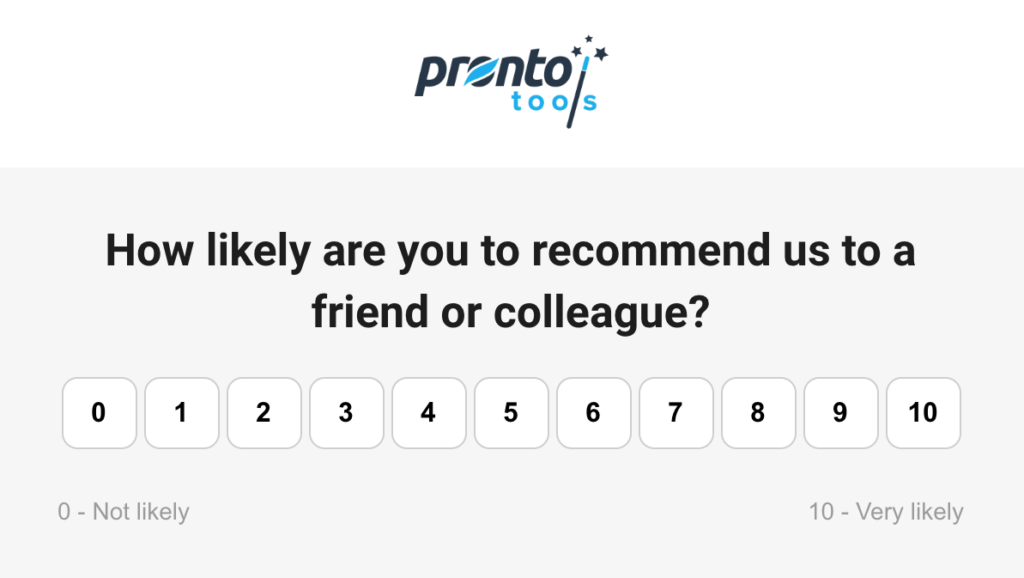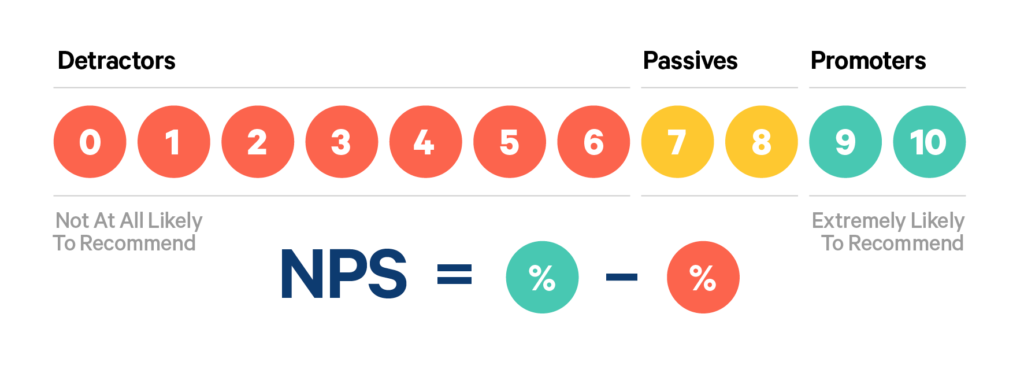Customers are important, but so is customer retention.
Keeping customers around means they’ll keep buying from you, giving you a steady income stream. That’s why churn rate is such a crucial metric to measure for your online store.
Although churn rate is typically used by SaaS companies, many e-commerce businesses started adopting this metric to measure customer loyalty over a longer time period.
To reduce churn and improve loyalty, you should keep an eye on your Net Promoter Score (NPS) and actively work on improving this score.
In this guide, we’ll cover all the basics of e-commerce NPS and how you can implement it to improve customer satisfaction.
Let’s begin.
Table of Contents
What is Net Promoter Score (NPS)?

Image Source: Pronto Marketing
NPS is a metric that measures how many customers are willing to recommend your products to other people. Think of it as a measurement to know how loyal your customers are to your product or service.
This is a crucial metric every business owner should keep track of because it gives them a direct insight into customer satisfaction and brand loyalty.
Andy Taylor, the CEO of Enterprise Rent-A-Car, wanted to ditch the typical bulky customer satisfaction surveys to enhance customer loyalty efforts.
He came up with an approach that aligns with the concept of the NPS, where his team blasted out monthly polls that asked users two simple questions:
- How was the quality of your rental car experience?
- Are you likely to rent from the company again?
Within a week, the company had raised results for 5000 US branches, which gave them real-time feedback on their performance and improvement areas at an unparalleled speed.
While Taylor was a visionary, it was Fred Reichheld that came up with the Net Promoter Score system after years of research and testing. And the main reason behind designing the Net Promoter Score is to effectively gauge customer loyalty.
All companies have to do was get answers to a single question: “How likely is it that you recommend (Your Company) to a friend?”
How to Calculate NPS
Your goal with NPS is to learn how likely it is for your customers to recommend your products. And that’s exactly what you should be asking in your survey.
However, instead of asking for a simple “yes” or “no” answer, have respondents choose a rating between 0 and 10. After you collect all the answers, group them in the following way:
- Promoters – People who respond with 9-10.
- Passage – People who respond with 7-8.
- Detractors – People who respond with 0-6.
Let’s explain what each group means.
Promoters
Promoters are your satisfied and loyal customers. These are the people that would recommend your company or website to others.
Promoters are easier to manage and cultivate a long-term relationship with. That said, you can improve your relationship with promoters by sending them exclusive discounts, free delivery, guides, free eBooks, and so on.
Passives
Passives are satisfied yet not enthusiastic customers. This group covers the people who aren’t necessarily excited about their experience with your company.
Your goal should be to convert passives into promoters for a better NPS. Otherwise, you’ll risk them turning into detractors.
Detractors
Simply put, detractors are unhappy customers. It’s highly unlikely for them to recommend your product or service to others. This may cause negative word-of-mouth, which can put a serious dent in your profits.
Make your customers feel special and they’ll become your biggest assets. But make them feel mistreated and your sales will go down fast.
Ask follow-up questions to find out why detractors had an unpleasant experience in your store and find solutions to improve that specific aspect of your business. In the long run, a detractor may convert into a passive or even a promoter.
But how do you calculate your overall NPS?

It’s simple: Subtract the percentage of detractors from the percentage of promoters.
Let me explain with an example.
Suppose you survey 100 customers. You find out that 64 percent of them are your promoters, while 12 percent are your detractors.
So your NPS will be 64–12=52.
What Is a Good NPS Score?
A net promoter score below zero means your business has serious issues that need to be addressed immediately. On the other hand, any score between 0 and 30 is a good range to be in. There’s still room for improvement, though.
Getting a score higher than 30 means your e-commerce company has a healthy ratio of happy customers to unhappy ones. For comparison, SPG Consulting found that the average NPS is 34.3.
An NPS of over 70 means you’re thriving. You’re doing things right—your customers like you, and your company is likely generating positive word-of-mouth through referrals.
Why Is NPS Crucial for Your E-Commerce Store?
Building an army of promoters comes doesn’t happen overnight.
There are certain things you need to take care of to ensure high customer satisfaction. This includes a user-friendly e-commerce site, a personalized shopping experience, responsive customer service, and repeatedly implementing customer feedback.
NPS Eliminates Negative Word-of-Mouth
When customers say good things about you, it’ll help you boost your business.
In a study, BrightLocal found that 84 percent of participants use online reviews and friends to determine which products or services to use. Use NPS surveys to find your true advocates and incentivize them to ensure positive word-of-mouth and increase referrals.
Don’t forget about your detractors, though. Brainstorm ways to turn them into ambassadors to prevent any negative publicity.
NPS Establishes Customer Loyalty and Promotes Growth
It doesn’t take more than one percent to make a big difference.
iiNet achieved an additional $1.6 million net profit following a one percent increase in its NPS score.
To implement NPS on your e-commerce site, you can choose one of the tools in the market that regularly tracks your scores. Tools like GetFeedback or Survicate gather and analyze data in real-time to improve your customer satisfaction and sales.
NPS Develops a Competitive Edge Over Competitors
Over the past years, e-commerce websites have shown exceptional growth, which means you’re likely facing stiff competition in the market.
By using your NPS feedback, you can actively address customer problems and understand every issue a customer faces that can negatively affect customer satisfaction.
Carefully analyze your data to gain more insights into customer behavior and understand how they interact with your business.
How to Implement NPS in E-Commerce
Now that we’ve covered the importance of NPS and how to calculate it, let’s figure out how you can use it to further contribute to your e-commerce goals.
Give Every Customer Equal Importance
Your NPS score depends on how accurately you survey your customers. If your NPS survey only reaches a selective group of customers, you’ll get an artificially high or low score, which, in turn, will make it difficult for you to take action.
For instance, if your e-commerce store allows both registered and unregistered customers to check out, you must survey both groups. If only registered customers take part in your survey, you risk seeing an artificially high score.
Overall, you need a consistent NPS process and a fair sample of your customers to avoid producing skewed results.
Go Beyond the Score
NPS should be simple. Ironically, it’s the same simplicity that can be its biggest weakness.
Many e-commerce managers see NPS simply as a number, which makes them shift all their focus on moving the number upwards at all costs.
A better approach is to go through the comments from your customers, especially detractors, and identify the potential issues in your sales, payment, and order fulfillment processes. This way, you’ll be able to eliminate factors that hurt the customer experience.
Motivate Your Team to Improve their Performance
Customer loyalty is the very foundation of the NPS system. Unfortunately, though, creating a company that maintains loyalty isn’t something that is achieved overnight.
You and your employees have to be receptive to your customers and improving their experiences. Making your employees embrace the NPS spirit by tying their performances to it can be a good starting point to get better results.
Prioritize Improvement, Not Benchmarks
NPS benchmarks can help you estimate the range your score falls within, but you shouldn’t use them to directly compare your business with your competitors.
Most NPS benchmark reports are problematic because they group businesses into broad categories. Small e-commerce stores end up in the same category as big shots like Amazon, creating unreliable results.
Instead of focusing on meeting the average, you should prioritize the continuous improvement of your business and NPS over the long term.
Don’t Forget “Closing the Loop”
Once you collect customer feedback, remember to take action and respond directly to the customer’s concerns, compliments, or complaints.
Data shows that even a 5 percent increase in customer retention can result in a 25-95 percent improvement in profit. Therefore, you should remember to close the loop with detractors after implementing NPS.
Over to You
That was everything you need to know about e-commerce NPS.
Keeping an eye on your NPS can help you understand your target customers better, know their likes and dislikes, and improve any shortcomings and flaws in your online store.
You can’t expect overnight change, but by actively tracking NPS, you can eventually create an army of loyal customers, leading to more revenue in the future.



